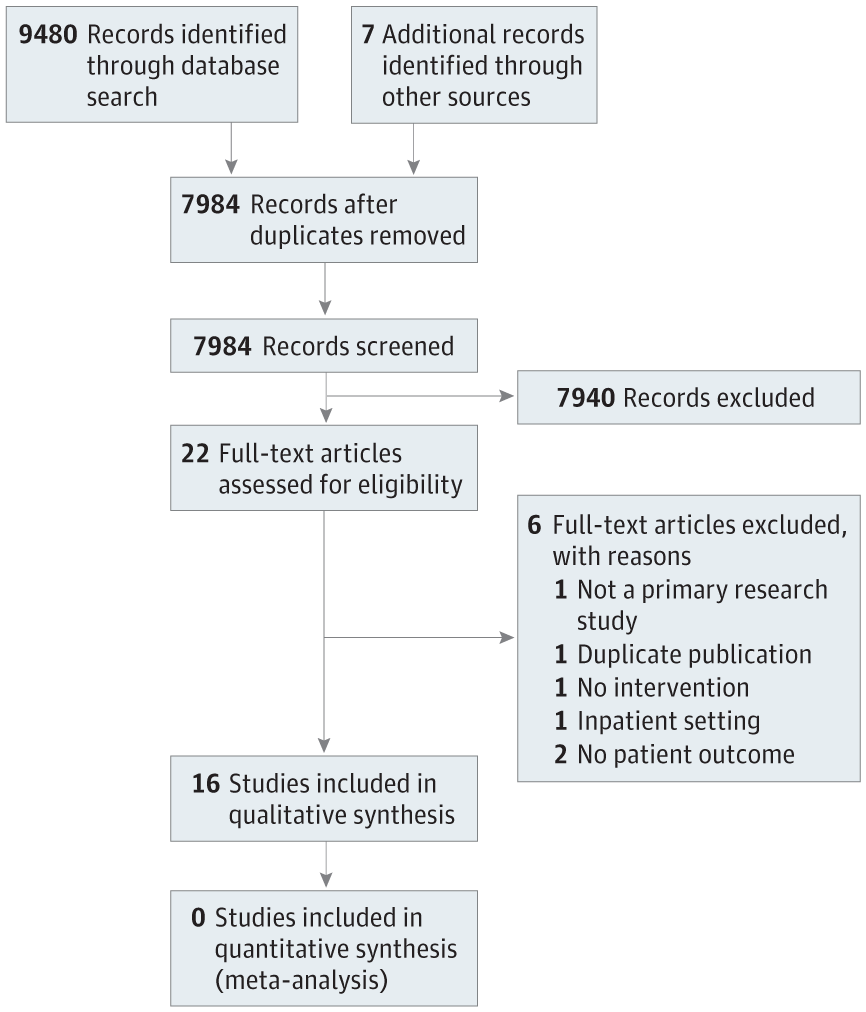JAMA Oncology ( IF 22.5 ) Pub Date : 2018-01-01 , DOI: 10.1001/jamaoncol.2017.0625 Jessica A Zerillo 1, 2 , Benjamin A Goldenberg 3, 4 , Ritesh R Kotecha 1 , Alok K Tewari 1, 2 , Joseph O Jacobson 2 , Monika K Krzyzanowska 3

|
Importance With the growing use of oral chemotherapy, there is an urgent need to develop safe and effective systems to administer and manage these agents. A comprehensive synthesis of literature on oral chemotherapy care delivery programs to which clinicians can look for best practices is lacking.
Objective To summarize the peer-reviewed and gray literature on interventions to improve oral chemotherapy care delivery toward describing best practices and identifying current gaps.
Evidence Review Using search terms pertaining to the concepts of oral chemotherapy, cancer, and interventions and outcomes, we performed a systematic review of PubMed, EMBASE, and CINAHL from January 1995 to May 24, 2016, to identify oral chemotherapy intervention programs. We searched the gray literature from January 1995 through February 2016 and contacted gray literature authors for further information. Four physician abstractors reviewed the titles, abstracts, and articles. Quality of the articles was assessed using SQUIRE2 guidelines. Interventions were evaluated in the categories of prescribing, preparation/dispensing, education, administration, monitoring, and storage/disposal. The population of interest included all ages and was limited to traditional cytotoxic and targeted anticancer oral agents.
Findings From 7984 abstracts identified in the peer-reviewed literature search, 16 full-text articles met inclusion criteria representing 3612 patients. Interventions focused on prescribing (n = 1), preparation/dispensing (n = 2), education (n = 11), administration (n = 5), monitoring (n = 14), and storage/disposal (n = 1). In the 10 articles with adherence as the primary outcome, 4 evaluation methods were used. Most improvements were seen in toxic effects/safety compared with adherence. Of the 7 interventions with statistically significant improvement in the primary outcome, 3 nursing phone calls to contact patients within the first few days after treatment initiation, 2 of them with standardized toxic effects management protocols. Interventions using technology to increase touch points between care teams and patients (including video directly observed therapy, automated voice response, and text messages) were not effective.
Conclusions and Relevance A framework for the oral chemotherapy management process with standardized outcome definitions is needed to ensure constructive research. Existing data suggest that a monitoring program should include personal contact with patients within the first weeks of treatment. Whether such contact can be enhanced by technology is uncertain.
中文翻译:

提高口服化疗安全性和质量的干预措施系统评价
重要性 随着口服化疗的日益普及,迫切需要开发安全有效的系统来管理和管理这些药物。缺乏临床医生可以寻找最佳实践的口服化疗护理实施方案的综合文献。
目的 总结同行评议和灰色文献中关于改善口服化疗护理提供的干预措施,以描述最佳实践和确定当前差距。
证据审查 使用与口服化疗、癌症、干预措施和结果相关的搜索词,我们在 1995 年 1 月至 2016 年 5 月 24 日期间对 PubMed、EMBASE 和 CINAHL 进行了系统评价,以确定口服化疗干预方案。我们检索了 1995 年 1 月至 2016 年 2 月的灰色文献,并联系了灰色文献作者以获取更多信息。四位医师摘要审查了标题、摘要和文章。文章的质量使用 SQUIRE2 指南进行评估。在处方、准备/分配、教育、管理、监测和储存/处置等类别中评估干预措施。感兴趣的人群包括所有年龄段,并且仅限于传统的细胞毒性和靶向抗癌口服药物。
发现 从同行评审文献检索中确定的 7984 篇摘要中,16 篇全文文章符合纳入标准,代表 3612 名患者。干预措施侧重于处方 (n = 1)、制备/分配 (n = 2)、教育 (n = 11)、管理 (n = 5)、监测 (n = 14) 和储存/处置 (n = 1)。在以依从性为主要结果的 10 篇文章中,使用了 4 种评估方法。与依从性相比,毒性作用/安全性方面的大部分改进。在主要结果具有统计学显着改善的 7 项干预措施中,3 次护理电话在治疗开始后的最初几天内联系患者,其中 2 次采用标准化的毒性反应管理方案。
结论和相关性 需要一个具有标准化结果定义的口服化疗管理过程框架,以确保建设性研究。现有数据表明,监测计划应包括在治疗的最初几周内与患者的个人接触。这种联系是否可以通过技术加强尚不确定。











































 京公网安备 11010802027423号
京公网安备 11010802027423号